通过热带季风(亚马逊)和半干旱红树林土壤分解过程评估蓝碳汇
IF 2.1
4区 环境科学与生态学
Q3 ECOLOGY
引用次数: 0
摘要
红树林土壤中的蓝碳(C)储存与盐碱化条件下厌氧有机物(OM)分解有关。因此,研究红树林的分解对评估影响碳储量的因素具有重要意义,这是适应气候变化的关键策略。因此,在对比气候区域(季风亚马逊和半干旱)的巴西红树林中,使用标准化分解方法(例如,茶包指数- TBI)评估了OM分解。我们的研究结果表明,与半干旱地区相比,季风亚马逊地区的绿茶分解更大(~ 25天:亚马逊= 75 %;半干旱= 60 %;~ 90天:亚马逊= 85 %;半干旱= 70 %)和路易波士茶(~ 25天:亚马逊= 28 %;半干旱= 20 %;∼90天:亚马逊= 37 %;半干旱= 30 %)。分解速率(k)和稳定因子(S)与湿地生态系统的观测结果一致,孵育开始(~ 25天)时的值高于孵育间隔(~ 90天)(kmean ~ 25 - 90天:亚马逊= 0.03-0.01;半干旱= 0.02-0.01);(平均~ 25 ~ 90天:亚马逊= 0.10 ~ 0.13;半干旱= 0.28-0.16),表明OM分解可能趋于稳定。除了气候差异外,亚马逊河流域和半干旱区的OM浓度、k和S值也与区域差异有关,如树种和大小(净初级生产力)、土壤成分(物理化学条件、粘土组合、氧化铁含量)、河流输入和潮汐差。因此,分解过程的区域差异可能是一个一致的指标,表明C循环可以沿着热带海岸线发生重大变化,并容易受到全球环境变化的影响。本文章由计算机程序翻译,如有差异,请以英文原文为准。
Assessing blue carbon sink through the soil decomposition processes in tropical monsoon (Amazon) and Semiarid mangroves
Blue carbon (C) storage in mangroves soils is linked to the anaerobic organic matter (OM) decomposition under saline conditions. Therefore, studies concerning the decomposition in mangroves are relevant to evaluate factors that could affect C storage, a pivot strategy to climate change adaptation. Thus, OM decomposition was assessed using a standardized decomposition method (e.g., Tea Bag Index - TBI) in Brazilian mangroves in contrasting climate regions (monsoon Amazon and Semiarid). Our results indicated greater decomposition at monsoonal Amazon compared with a Semiarid region for green tea (∼25-days: Amazon = 75 %; Semiarid = 60 %; ∼90-days: Amazon = 85 %; Semiarid = 70 %), and rooibos tea (∼25-days: Amazon = 28 %; Semiarid = 20 %; ∼90-days: Amazon = 37 %; Semiarid = 30 %). The decomposition rate (k) and stabilisation factor (S) were consistent with observed results in wetland ecosystems, with higher values at the beginning of incubation (∼25 days), compared to ∼90-days interval (kmean ∼25–90 days: Amazon = 0.03–0.01; Semiarid = 0.02–0.01); (Smean ∼25–90 days: Amazon = 0.10–0.13; Semiarid = 0.28–0.16), indicating a possible trend towards the stabilisation of OM decomposition. Climate differences aside, OM concentration, k, and S values in the Amazon and Semiarid regions can be linked to regional differences, such as tree species and size (net primary productivity), soil composition (physico-chemical conditions, clay assemblages, iron oxide content), river inputs, and tidal range. Therefore, regional differences in the decomposition process are likely to be a consistent indicator that the C cycle can vary substantially along tropical coastlines and is susceptible to global environmental changes.
求助全文
通过发布文献求助,成功后即可免费获取论文全文。
去求助
来源期刊

Regional Studies in Marine Science
Agricultural and Biological Sciences-Ecology, Evolution, Behavior and Systematics
CiteScore
3.90
自引率
4.80%
发文量
336
审稿时长
69 days
期刊介绍:
REGIONAL STUDIES IN MARINE SCIENCE will publish scientifically sound papers on regional aspects of maritime and marine resources in estuaries, coastal zones, continental shelf, the seas and oceans.
 求助内容:
求助内容: 应助结果提醒方式:
应助结果提醒方式:


